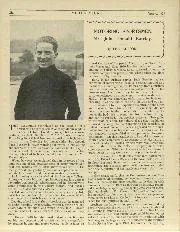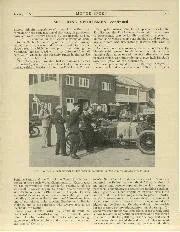

MOTORING SPORTSMEN.
MOTORING SPORTSMEN. Mr. John Donald Barclay. By THE Forrok. THE photograph reproduced at the head of this article will be recognised at once by all our readers as that of…
A CZECHOSLOVAKIAN LIGHT CAR
A GOOD PERFORMER ON ROUGH OADS
Al4tHOUGH well known to British competitors as a consistent performer in the Alpine Trial, the Tatra is little known to the English motoring public in general. But the possibility of manufacturing it in this country is being explored, more especially for export to the Dominions and Colonies, in addition to the home market, by Capt. D. Fitzmaurice, of 122a, High Street, St. John’s Wood, London, N.W.3.
In view of the Tatra’s proved suitability for competition work of the long distance reliability trial type, we recently took the opportunity of trying for ourselves the behaviour of the car on a variety of roads. But the characteristics of the Tatra’s road performance can be appreciated more thoroughly when its design is borne in mind, and a few details of its construction will assist the reader in this respect.
To begin with the engine is air-cooled, and the two pairs of cylinders are horizontally opposed. The cubic capacity is 1,154 c.c. and in other respects the engine follows normal design. Cooling is assisted by a large vaned-blower which is driven direct off the nose of the crankshaft. An orthodox clutch and gear box takes the drive to the back axle, and so to the rear wheels by means of spiral bevel wheels and a differential. But it is in the” chassis” that the Tatra departs so widely from current practice, the tubular propeller-shaft casing being the ” backbone ” of the car, instead of the usual frame members. Then all four wheels are independently sprung, those in front by two parallel transverse springs, with shock absorbers, while a single transverse spring is fixed to the top of the rear axle casing.
Steering is by a simple rack-and-pinion gear, each front wheel being controlled independently by two rods. Normal four wheel brakes are employed, cable oper-. ated. The body is fixed to the” chassis” by means of two .aorizontal girders, fore and aft, which are slung from the tubular backbone by means of inverted U bolts.
The advantage of this feature for rough roads is immediately apparent, for there is no chassis to flex, and the body is therefore never subject to distortion.
Enough has now been said to show that the performance of the car should prove exceptionally interesting. Soon after leaving High Street, St. John’s Wood, an advantage of independent springing and absence of chassis frame was immediately revealed when we took a wrong road, and found ourselves able to turn round without reversing in a remarkably small area. On making our way Northwards through traffic, we were able to obtain some first impressions of the car, and to give the car justice it is necessary to clear from one’s mind certain preconceived ideas of motoring as we know it. No finer way of judging a car can be used than that of asking oneself” For what purpose was this motor car built ? ” and one’s verdict should be based on the extent to which the car fulfills the demands included in the answer. By our standards the roads of Central Europe are appalling, even the main trunk
THE TATRA POSSESSES MANY ORIGINAL CHARACTERISTICS BOTH OF DESIGN AND PERFORMANCE.
roads having an atrocious surface. Demand No. 1, the car shall be well sprung, and strong, so that pieces will not drop off. Next, Alpine passes must be frequently crossed, requiring adequate cooling in hot weather, while on the other hand the danger of cracked radiators and cylinder blocks in winter must be avoided. Demand No. 2, efficient air cooling. Then no one has any money, and long distances have to be covered to big towns. Demand No. 3, the initial cost must be low, which involves a minimum amount of luxury both in comfort and in finish ; maintenance expense must be low, which necessitates a small efficient engine ; and the car must be practically unbreakable and never wear out.
If any manufacturer can build a car to satisfy these conditions no one will deny that he has done well, and it would be ungracious to cavil over such additional points as silent engine, gears and transmission, and soft leather upholstered seats.
One’s first impression is of a lack of silence, both in engine and transmission, the indirect gears being noisier than is usual nowadays. But one’s attention is soon drawn to the excellent handling of the car as a whole. The steering is light and accurate, and although there is no self-centering action the car possesses that fixed, steady line of direction at all speeds, which generally accompanies this asset. Cornering is safe at all speeds, and the car never gave the suspicion of a roll, even when we made circles in the road on full lock, gyrating rapidly in second gear. On average roads the suspension is no better than that of cars with normal springing, but a run down Bishop’s Avenue, Pinchley, showed the car at its best. At a speed of 30 m.p.h. we purposely chose the most bumpy course, over deep pot-holes and sharp bumps, severe enough to bring the normal car down to 10 m.p.h. The riding comfort of the Tatra was never
disturbed in the least, and although an extra bad patch of inequalities in the road surface would cause the car to pitch slightly, one never had that sensation of the ” chassis ” being badly flexed.
Back on the open road the Tatra showed its suitability for farmers who live some distance from a ‘ made ‘ road by settling down to a comfortable cruising speed of 47 m.p.h., showing that its ability to tackle rough surfaces and steep hills has not been obtained by sacrificing more normal attributes. Incidentally, the highest speed attained during our test was 57 m.p.h., while on 3rd gear we found the maximum to be 35 m.p.h. The clutch is smooth and light, while the gear change is straightforward. The engine pulls evenly away from slow speeds, and has a happy way of hanging on in top gear up long main road hills. For steeper hills third gear provides a fair
turn of speed, West Hill, Highgate, being taken at 30 m.p.h. on this gear without rushing the lower slope. The brakes, although not fierce, are effective and even in operation, and both hands can be raised from the wheel while they are being applied without causing any appreciable deviation.
The body of the car we tested was outwardly an occasional four-seater coupe, but such was the comfort of the rear seats that the car was in effect a full saloon. This was all the more remarkable in that the rear passengers sit within the wheelbase. Owing to the unusual chassis design the floor is flat, no wells being employed, although the tubular ” backbone ” passes down the centre. The front seats are of the steel tube and. webbing type, and at first seem to be lacking in “give,” but their curve is so supporting to the back that complete comfort is provided.
The roof can be rolled back, and the rear quarter folded, thereby converting the car into an open body.
Finally, the general originality of the car is completed by the fact that the whole of the bonnet, front mudguards and headlamps are made in one piece, and are hinged to give access to the engine, which is thus rendered extraordinarily accessible.
We found the Tatra a very attractive little car, which overcomes the disadvantages of a certain roughness in construction by its enjoyable control. For general utility purposes in a climate of extremes, the Tatra would be hard to beat, being equally at home on rough and smooth roads ; built for hill-climbing of the Alpine Pass nature ; and possessing an immense amount of strength and longevity.



